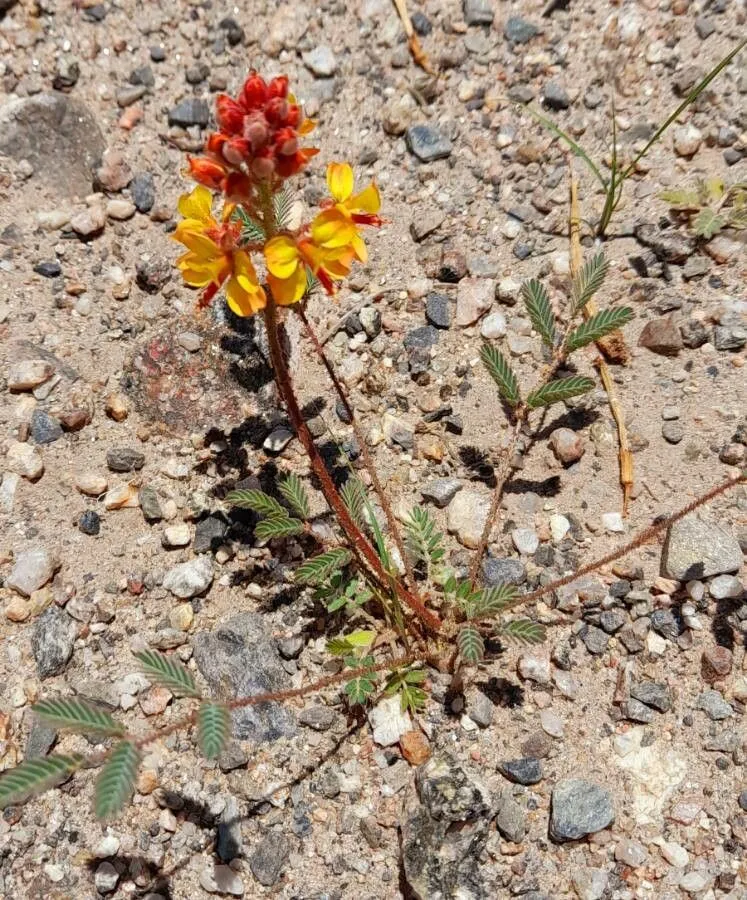
Author: (Ortega) Eifert
Bibliography: Sida 5: 43 (1972)
Year: 1972
Status: accepted
Rank: species
Genus: Hoffmannseggia
Vegetable: False
Observations: SW. & C. U.S.A. to Mexico, Bolivia to S. South America
Pignut, scientifically known as Hoffmannseggia glauca, is a fascinating plant belonging to the Fabaceae family. This perennial herbaceous plant is distinguished by its hardy nature and adaptability to various climates and soils, making it a remarkable species within its genus.
Native to a wide geographical range, Pignut is found in the southwestern and central regions of the United States, stretching down through Mexico and extending as far south as Bolivia and southern South America. This extensive distribution highlights the plant’s versatility and resilience in different ecosystems.
Hoffmannseggia glauca was first described scientifically in the year 1972, as noted in the Sida journal, indicating its relatively recent classification in botanical literature. The taxonomic name honors the early botanist Ortega, with further classification attributed to Eifert, who recognized and documented the species’ unique characteristics.
The plant itself is notable for its attractive foliage and growth form. Pignut thrives in arid and semi-arid environments, often found in well-drained soils where it contributes positively to the local ecology. It forms part of the legume family, which is well-known for its ability to fix nitrogen in the soil, thus enhancing soil fertility.
In terms of its physical attributes, Hoffmannseggia glauca typically presents with compound leaves, bright yellow flowers, and distinctive seed pods that set it apart visually from other native flora. These flowers not only add a splash of color to their surroundings but also play a crucial role in attracting pollinators, thus supporting the broader ecological web.
Its common name, Pignut, is derived from the small, nut-like tubers it produces underground, which have historically been utilized as a food source for both humans and wildlife. These tubers are rich in nutrients, making them a vital part of the diet for various animal species within its habitat range.
Overall, Hoffmannseggia glauca is not only a plant of botanical interest but also of ecological importance. Its widespread presence across the Americas underscores its adaptability and the critical role it plays in sustaining the environmental health of the regions it inhabits. Understanding and preserving this species is essential as part of ongoing efforts to maintain biodiversity and ecosystem stability.
Eng: indian rush-pea, indian rushpea, hog potato, hog-potato, pignut
En: Pignut, Indian rush-pea, Hog-potato, Indian rushpea, Waxy Rush-Pea, Hogpotato, Shoestring weed, Hog potato
Taken Jan 6, 2022 by Trap Hers (cc-by-sa)
Taken Jan 6, 2022 by Trap Hers (cc-by-sa)
Taken Jan 6, 2022 by Trap Hers (cc-by-sa)
Taken Jan 6, 2022 by Trap Hers (cc-by-sa)
Taken Jan 7, 2022 by Trap Hers (cc-by-sa)
Taken Nov 12, 2021 by P. Sonja (cc-by-sa)
Taken Jan 6, 2022 by Trap Hers (cc-by-sa)
Taken Jan 6, 2022 by Trap Hers (cc-by-sa)
Taken Oct 22, 2022 by Trap Hers (cc-by-sa)
Taken Oct 3, 2019 by baldini Giulianna (cc-by-sa)
© copyright of the Board of Trustees of the Royal Botanic Gardens, Kew.
Taken Jun 23, 2014 by EOL − Carlos Velazco (cc-by-nc)
Taken Jun 23, 2014 by EOL − Carlos Velazco (cc-by-nc)
Taken Jan 7, 2022 by Trap Hers (cc-by-sa)
Taken Jan 6, 2022 by Trap Hers (cc-by-sa)
Taken Oct 22, 2022 by Trap Hers (cc-by-sa)
Taken Jan 8, 2015 by EOL − Keir Morse (cc-by-nc-sa)
Taken Jan 8, 2015 by EOL − Keir Morse (cc-by-nc-sa)
Taken Jan 8, 2015 by EOL − Keir Morse (cc-by-nc-sa)
Taken Jan 1, 1900 by EOL − Niehaus, T.F. (cc-by-nc-sa)
Growth habit>: Subshrub, Forb/herb
Family: Myrtaceae Author: (F.Muell.) K.D.Hill & L.A.S.Johnson Bibliography: Telopea 6: 402 (1995) Year: 1995 Status:…
Family: Rubiaceae Author: Pierre ex A.Froehner Bibliography: Notizbl. Bot. Gart. Berlin-Dahlem 1: 237 (1897) Year:…
Family: Sapindaceae Author: Koidz. Bibliography: J. Coll. Sci. Imp. Univ. Tokyo 32(1): 38 (1911) Year:…
Family: Asteraceae Author: A.Gray Bibliography: Pacif. Railr. Rep.: 107 (1857) Year: 1857 Status: accepted Rank:…
Family: Fabaceae Author: Medik. Bibliography: Vorles. Churpfälz. Phys.-Ökon. Ges. 2: 398 (1787) Year: 1787 Status:…
Family: Aspleniaceae Author: (Cav.) Alston Bibliography: Bull. Misc. Inform. Kew 1932: 309 (1932) Year: 1932…